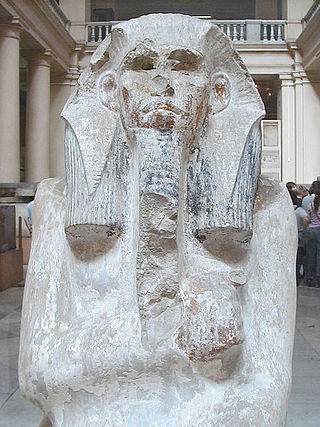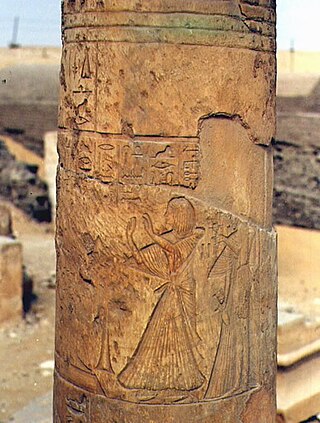Related Research Articles

Memphis, or Men-nefer, was the ancient capital of Inebu-hedj, the first nome of Lower Egypt that was known as mḥw ("North"). Its ruins are located in the vicinity of the present-day village of Mit Rahina, in markaz (county) Badrashin, Giza, Egypt. This modern name is probably derived from the late Ancient Egyptian name for Memphis mjt-rhnt meaning "Road of the Ram-Headed Sphinxes".

Saqqara, also spelled Sakkara or Saccara in English, is an Egyptian village in the markaz (county) of Badrashin in the Giza Governorate, that contains ancient burial grounds of Egyptian royalty, serving as the necropolis for the ancient Egyptian capital, Memphis. Saqqara contains numerous pyramids, including the Pyramid of Djoser, sometimes referred to as the Step Tomb, and a number of mastaba tombs. Located some 30 km (19 mi) south of modern-day Cairo, Saqqara covers an area of around 7 by 1.5 km.

Djoser was an ancient Egyptian pharaoh of the 3rd Dynasty during the Old Kingdom, and was the founder of that epoch. He is also known by his Hellenized names Tosorthros and Sesorthos. He was the son of King Khasekhemwy and Queen Nimaathap, but whether he was also the direct successor to their throne is unclear. Most Ramesside king lists identify a king named Nebka as preceding him, but there are difficulties in connecting that name with contemporary Horus names, so some Egyptologists question the received throne sequence. Djoser is known for his step pyramid, which is the earliest colossal stone building in ancient Egypt.
Teti, less commonly known as Othoes, sometimes also Tata, Atat, or Athath in outdated sources, was the first king of the Sixth Dynasty of Egypt. He was buried at Saqqara. The exact length of his reign has been destroyed on the Turin King List but is believed to have been about 12 years.

Merneptah or Merenptah was the fourth pharaoh of the Nineteenth Dynasty of Ancient Egypt. He ruled Egypt for almost ten years, from late July or early August 1213 BC until his death on 2 May 1203 BC, according to contemporary historical records. He was the first royal-born pharaoh since Tutankhamun of the Eighteenth Dynasty.

Bintanath was the firstborn daughter and later Great Royal Wife of the Egyptian Pharaoh Ramesses II.

Abusir is the name given to an ancient Egyptian archaeological pyramid complex comprising the ruins of 4 kings' pyramids dating to the Old Kingdom period, and is part of the Pyramid Fields of the Memphis and its Necropolis UNESCO World Heritage Site.

Merneith was a consort and a regent of Ancient Egypt during the First Dynasty. She may have been a ruler of Egypt in her own right, based on several official records. If this was the case and the earlier royal wife Neithhotep never ruled as an independent regent, Merneith may have been the first female pharaoh and the earliest queen regnant in recorded history. Her rule occurred around 2950 BC for an undetermined period. Merneith’s name means "Beloved by Neith" and her stele contains symbols of that ancient Egyptian deity. She may have been Djer's daughter and was probably Djet's senior royal wife. The former meant that she would have been the great-granddaughter of unified Egypt's first pharaoh, Narmer. She was also the mother of Den, her successor.
Prince Khaemweset was the fourth son of Ramesses II and the second son by his queen Isetnofret. His contributions to Egyptian society were remembered for centuries after his death. Khaemweset has been described as "the first Egyptologist" due to his efforts in identifying and restoring historic buildings, tombs and temples.

Isetnofret was one of the Great Royal Wives of Pharaoh Ramesses II and was the mother of his successor, Merneptah. She was one of the most prominent of the royal wives, along with Nefertari, and was the chief queen after Nefertari's death.

Tia or Tiya was an ancient Egyptian princess during the 19th Dynasty.
Iput I was a Queen of Egypt, a daughter of King Unas, the last king of the Fifth Dynasty of Egypt. She married Teti, the first Pharaoh of the Sixth Dynasty of Egypt. Their son was Pepi I Meryre. She possibly ruled as regent for her son Pepi I.
Isetnofret(3s.t-nfr.t; also spelled as Isetneferet, Isisnofret etc.) was an ancient Egyptian female name, meaning “Isis is beautiful”.

Isetnofret was a royal woman of Ancient Egypt and, as the Great Royal Wife of Pharaoh Merenptah, she became Isetnofret II.
Neferhetepes was the wife of the Ancient Egyptian king Userkaf, who was the first pharaoh of the Fifth Dynasty. She was the mother of king Sahure, Userkaf's successor, and she was most likely the mother of Meretnebty, Sahure's wife. Neferhetepes' most important titles were mother of the king of Upper and Lower Egypt and daughter of the god.

The Serapeum of Saqqara was the ancient Egyptian burial place for sacred bulls of the Apis cult at Memphis. It was believed that the bulls were incarnations of the god Ptah, which would become immortal after death as Osiris-Apis, a name which evolved to Serapis (Σέραπις) in the Hellenistic period, and Userhapi (ⲟⲩⲥⲉⲣϩⲁⲡⲓ) in Coptic. It is part of the Saqqara necropolis, which includes several other animal catacombs, notably the burial vaults of the mother cows of the Apis.

Tia was an ancient Egyptian high official under king Ramses II. His main title was that of an overseer of the treasuries. Tia was married to a woman with the same name, the princess Tia who was sister of Ramses II.
Wahtye was a high-ranking priest and official who served under King Neferirkare Kakai during the Fifth Dynasty of Egypt. Based on his skull, he was probably 35-years-old when he died.

Setibhor was an ancient Egyptian queen from the End of the 5th Dynasty. She was most likely the wife of king Djedkare. She had several titles including Friend of HorusThe one who sees Horus and Seth, the great one of the hetes sceptre, the great of praise and king’s wife, his beloved.
References
- ↑ Nozomu Kawai: The New Kingdom Tomb Chapel of Isisnofret at Northwest Saqqara, in: Jiro Kondo (editor): Quest for the Dream of the Pharaohs, Studies on Honour of Sakuji Yoshimura, Cairo 2014, ISBN 978-977-6420-03-8, p. 69-90